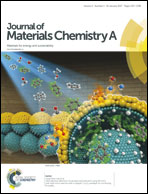Grain boundary engineering in organic–inorganic hybrid semiconductor ZnS(en)0.5 for visible-light photocatalytic hydrogen production†
Abstract
A pile of unique grain boundary-engineered ZnS(en)0.5 nanosheets (D-ZnS(en)0.5 NSs) are constructed via a solvothermal process. Large amounts of stacking fault and dislocation in D-ZnS(en)0.5 at the boundaries could create mid-gap defect states, in which intraband transition and carrier creation are induced under visible light irradiation. Meanwhile, a defect-rich structure with a quasiperiodic configuration endows the integrated polycrystalline NSs with preferable electrical properties. Owing to the enriched defect-state excitation and optimized electrical properties, D-ZnS(en)0.5 exhibits superior visible-light-driven photocatalytic performance for hydrogen evolution from water. This work will provide a new strategy for achieving a visible-light organic–inorganic hybrid photocatalyst.



 Please wait while we load your content...
Please wait while we load your content...